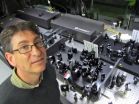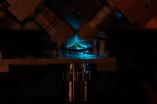(Press-News.org) Some vaccines are once-in-a-lifetime; others need a booster shot or two to maintain their potency. And then there's the flu vaccine, which only lasts a year. Strains of influenza virus change so much from year-to-year that new vaccines must be developed annually to target the strains of virus that are most likely to cause illness. But Howard Hughes Medical Institute (HHMI) scientists have now discovered a human antibody that recognizes many different flu strains. Understanding more about this antibody may help scientists design a longer-lasting vaccine against the influenza virus.
The research is published in the August 8, 2011, issue of the Proceedings of the National Academy of Sciences.
To find the new antibody, Stephen C. Harrison, an HHMI investigator at Harvard Medical School and Children's Hospital, Boston, took advantage of the diversity of the human immune system.
When given the flu vaccine, every person's body will produce slightly different antibodies, which are immune system molecules that recognize and remember pathogens, such as viruses. Antibodies are small compared to the flu virus, but they need only recognize one piece of the virus's outer shell to be effective. This means that within the human population, there's great diversity when it comes to antibodies that recognize flu. For example, some people will produce an antibody against one bit of the virus, while others have antibodies that recognize a different viral snippet, and so on.
Strains of flu virus differ from one another largely in the genes that code for surface molecules called glycoproteins, which are the primary targets of the body's immune system in defending against flu viruses. Like a coat of armor, the hemagglutinin and neuraminidase surface proteins stud the tiny influenza virus particle. When the virus mutates, it essentially "changes coats," altering the shape of its exterior surface and becoming unrecognizable to the human (or animal) immune system. This is the essence of immune evasion, a hallmark of influenza.
To study how the immune system determines which antibodies to produce, Harrison and collaborators at Duke University, turned to a new technology that lets scientists quickly scan the molecules in a person's immune cells.
"What this allows us to do is get a snapshot of the different kinds of antibodies being made in a person in response to a vaccine," says Harrison.
While the research team was taking such snapshots of immune cells, they found an antibody they weren't expecting—one that recognized multiple strains of the flu virus.
There's one part of the influenza virus that doesn't mutate—the binding area that recognizes receptors on human cells. If this receptor pocket mutates, the virus is no longer infectious. Scientists had previously believed that antibodies couldn't target this small area with such specificity.
"It has been assumed that because antibodies have a larger contact area than most virus receptors," says Harrison, "an antibody might target that receptor binding area, but it would still also recognize surrounding, changeable areas." This means if that surrounding area mutated, the antibodies wouldn't bind.
But the new antibody that the researchers isolated—dubbed CH65—binds so tightly to the receptor pocket that it appears not to be strongly affected if the surrounding area mutates. When collaborators at the U.S. Food and Drug Administration tested the new antibody against 36 flu strains that have arisen between 1988 to 2007, they found that the antibody recognized and blocked 30 of those strains.
While this knowledge could theoretically be used to develop a vaccine that stimulates production of the CH65 antibody, this could just push viruses to mutate in the area around the binding pocket. If this occurs, the vaccine would eventually become obsolete. Instead, Harrison would like to use CH65 to probe how the immune system chooses which antibodies to produce. If one person can make the broad CH65 antibody, why can't everyone? Can scientists learn to coax the human immune system to produce CH65?
"Our goal," he says, "is to understand how the immune system selects for antibodies and use that information to get better at making a vaccine that will take you in a direction that favors breadth over specificity."
Harrison is now collaborating with HHMI investigator Nikolaus Grigorieff at Brandeis University to get structural information on antibodies as they evolve in the immune system after vaccine administration. By taking structural snapshots of antibodies over time, they may be able to deduce a pattern in how the immune system selects which antibody structures to favor.
Others, however, may use CH65 in a more direct clinical setting. "Some scientists are thinking about therapeutic antibodies, which can be administered to patients with severe flu cases, or compromised immune systems, as a way of fighting the virus," says Harrison. "And this antibody is a very interesting molecule to consider for that."
### END
Newly discovered antibody recognizes many strains of flu virus
2011-08-09
ELSE PRESS RELEASES FROM THIS DATE:
Meteorites: Tool kits for creating life on Earth
2011-08-09
Washington, D.C.—Meteorites hold a record of the chemicals that existed in the early Solar System and that may have been a crucial source of the organic compounds that gave rise to life on Earth. Since the 1960s, scientists have been trying to find proof that nucleobases, the building blocks of our genetic material, came to Earth on meteorites. New research, published next week in the Proceedings of the National Academy of Sciences, indicates that certain nucleobases do reach the Earth from extraterrestrial sources, by way of certain meteorites, and in greater diversity ...
Biology, materials science get a boost from robust imaging tool
2011-08-09
EUGENE, Ore. -- (Aug. 8, 2011) -- Shape and alignment are everything. How nanometer-sized pieces fit together into a whole structure determines how well a living cell or an artificially fabricated device performs. A new method to help understand and predict such structure has arrived with the successful use a new imaging tool.
Coupling laser-driven, two-dimensional fluorescence imaging and high-performance computer modeling, a six-member team -- led by University of Oregon chemist Andrew H. Marcus and Harvard University chemist Alan Aspuru-Guzik -- solved the conformation ...
Guam researcher studies Mount Pinatubo ecosystem recovery
2011-08-09
University of Guam ecologist Thomas Marler recently mobilized efforts to characterize the vegetation that has recovered following the eruption of Mount Pinatubo, Philippines. "My interest was sparked by the paradox that this volcano's cataclysmic 1991 eruption was so powerful it changed global climate, yet after a full 15 years the biology of the recovering ecosystem had not been studied," said Marler.
The void of research motivated the Guam ecologist to spend a majority of 2006 conducting botanical surveys on the mountain. Marler then teamed up with University of Washington ...
Heavy metal -- in and around the lakes
2011-08-09
Heavy metal pollution of lakes has a seriously detrimental impact on people and ecosystems that rely on such bodies of water. According to a study published in the current issue of Interdisciplinary Environmental Review, researchers have focused on the physicochemical properties and toxicology of water from and around Thane City of Maharashtra.
Environmental chemist Pravin Singare of Bhavan's College, in Mumbai, and colleagues highlight the fact that fresh water bodies all over the world are becoming increasingly polluted day by day and that this represents a growing ...
Improved radical surgery techniques provide positive outcomes for bladder cancer patients
2011-08-09
Bladder cancer patients who have radical surgery at university hospitals can benefit from excellent local control of the disease, acceptable clinical outcomes and low death rates, according to research in the August issue of the urology journal BJUI.
Researchers studied 2,287 patients who had radical cystectomy surgery, where the bladder is removed, together with nearby tissue and organs as required. The surgery was performed at eight Canadian academic centres between 1998 and 2008.
The study found that there were three independent factors, apart from pathological ...
Live from the scene: Biochemistry in action
2011-08-09
Researchers can now watch molecules move in living cells, literally millisecond by millisecond, thanks to a new microscope developed by scientists at the European Molecular Biology Laboratory (EMBL) in Heidelberg, Germany. Published online today in Nature Biotechnology, the new technique provides insights into processes that were so far invisible.
By combining light-sheet microscopy and single molecule spectroscopy, the new microscope can record the fluorescence of every pixel within view, and take snapshots at intervals of less than one millisecond. With it, scientists ...
'Paranoia' about rivals alters insect mating behavior
2011-08-09
Scientists at the University of Liverpool have found that male fruitflies experience a type of 'paranoia' in the presence of another male, which doubles the length of time they mate with a female, despite the female of the species only ever mating with one male.
Females in many species of animal have multiple mates and males have evolved particular reproductive characteristics to ensure their sperm are successful when in competition with the sperm of other males. Adaptations include physical traits that result in increased sperm count, as well as behavioural alterations ...
Schoolchildren can also learn complex subject matters on their own
2011-08-09
Calculating the surface area of Gran Canaria is no easy task for a 14-year-old. It's not simply a question of learning the right formula. Students have to develop a strategy that enables them to put mathematical theory into practice – working out the information that is important and applying the right geometric models and tools. Realizing that the island has an almost circular shape and so its surface area can be approximated using the area of a circle is not as straightforward as it sounds. Are schoolchildren capable of developing these kinds of solutions themselves or ...
Light unlocks fragrance in laboratory
2011-08-09
In Anna Gudmundsdottir's laboratory at the University of Cincinnati, dedicated researchers endeavor to tame the extremely reactive chemicals known as radicals.
Highly reactive radicals are atoms, molecules or ions frantically trying to become something else. Their lifetimes are measured in fractions of seconds and typically occur in the middle of a chain of chemical reactions. They are also known as reactive intermediates. Much of Gudmundsdottir's work has focused on a family of radicals known as triplet nitrenes.
"Triplet nitrenes are reactive intermediates with high ...
Walking around is the simplest way to shorten hospital stay
2011-08-09
A new study from the University of Haifa has found that walking around the ward during hospitalization significantly reduces the length of the older patient's stay. "Given the over-occupancy of many hospitals, this finding can be of great importance," the researchers stated.
Walking around the ward during hospitalization reduces the length of geriatric patients' stay in internal wards. This has been shown in a new study by Dr. Efrat Shadmi and Dr. Anna Zisberg of the University of Haifa's Department of Nursing, funded by the Israeli Science Foundation and published in ...


